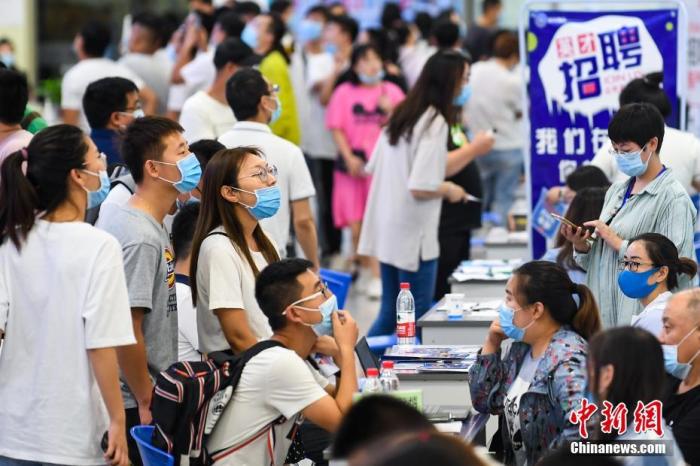Chinanews.com, August 27. According to the Chinese government website, the State Council recently issued the "14th Five-Year Plan for Employment Promotion" (hereinafter referred to as the "Plan").
The "Plan" mentioned that by 2025, the overall employment situation will be stable.
More than 55 million new jobs were created in urban areas, and efforts were made to achieve a larger scale. The urban surveyed unemployment rate was controlled within 5.5%, and the employment of key groups remained stable.
The gap in employment opportunities between urban and rural areas and regions has gradually narrowed, and the labor market has basically balanced supply and demand.
Data map: Job seekers are looking for jobs at the job fair.
Photo by China News Agency reporter Wu Junjie
The "Plan" requires that we adhere to employment orientation and policy coordination.
Continue to prioritize employment in economic and social development and macroeconomic policies, as the top priority to ensure and improve people’s livelihood, take stabilization and expansion of employment as the priority goal of macroeconomic control and the lower limit of a reasonable economic operation range, and adjust macroeconomic policies in a timely manner according to changes in the employment situation Orientation and concerted efforts to support employment.
Insist on expanding capacity and improving quality and optimizing structure.
Taking into account the capacity, quality and structure, grasping the main contradictions, while taking multiple measures to create more high-quality jobs, pay more attention to the increasingly prominent structural employment contradictions, focus on the improvement of the skill quality of workers, and focus on the training of technical and skilled personnel Training promotes the formation of a higher-level dynamic balance of supply and demand in the labor market.
Persist in market leadership and government regulation.
To promote a better integration of effective markets and effective government, it is necessary to adhere to the direction of market-oriented and socialized employment, speed up the removal of institutional and institutional barriers that restrict employment, and give full play to the decisive role of the market in allocating labor resources. It is also necessary to strengthen government responsibilities and optimize the integration of various types. Resources to provide strong policy support and basic service guarantee for employment promotion.
Insist on focusing on the key points and holding the bottom line.
Pay close attention to the key links and outstanding issues in the employment field, target key regions, key industries and key groups, formulate more precise and effective measures, strengthen classified assistance and assistance according to localities, enterprises and individuals, and earnestly secure the bottom line of people's livelihood.
The "Plan" proposes to achieve the following goals by 2025:
The employment situation is generally stable.
More than 55 million new jobs were created in urban areas, and efforts were made to achieve a larger scale. The urban surveyed unemployment rate was controlled within 5.5%, and the employment of key groups remained stable.
The gap in employment opportunities between urban and rural areas and regions has gradually narrowed, and the labor market has basically balanced supply and demand.
The quality of employment has steadily improved.
The increase in labor remuneration basically coincides with the increase in labor productivity. The social security system covering urban and rural workers has been improved, labor rights protection has been further strengthened, labor relations have been harmonious and stable, and more workers have achieved decent work.
Structural employment contradictions were effectively alleviated.
The quality of human resources has been greatly improved to better match the needs of industrial transformation and upgrading and high-quality development.
The total number of high-skilled talents nationwide has steadily expanded. The average number of years of education of the working-age population has reached 11.3 years, and the proportion of newly-increased laborers who have received higher education has reached 55%.
Entrepreneurship has continued to release the momentum for employment.
The leading role of entrepreneurship has become more prominent, and the ability to drive high-quality employment has been continuously enhanced.
The entrepreneurial environment is more optimized, the policy service system is more complete, there are more entrepreneurial opportunities and channels, and more people can realize the value of life through entrepreneurship.
Risk response capabilities have been significantly enhanced.
The employment field risk monitoring and early warning and response and disposal mechanisms have been continuously improved, the scope of protection for the unemployed has been effectively expanded, the level of protection has been further improved, the needy groups have received timely assistance, and employment safety protection has become more effective.

